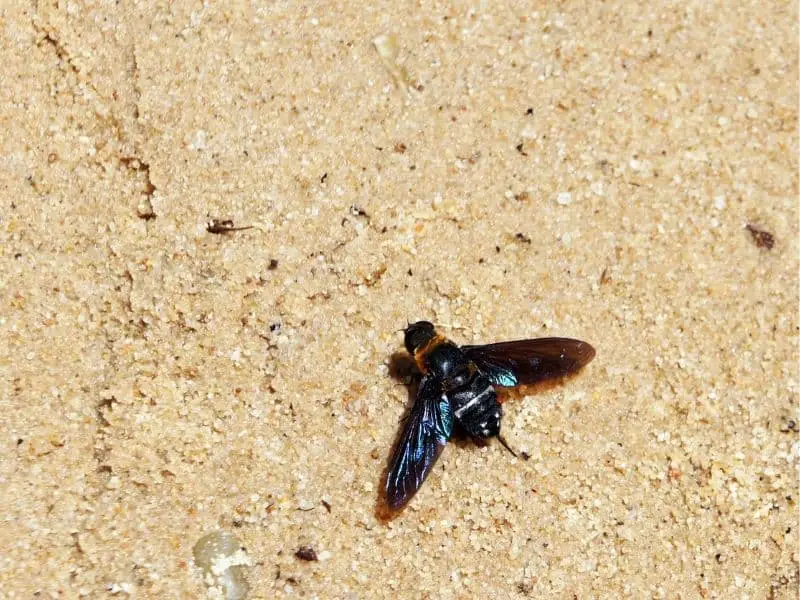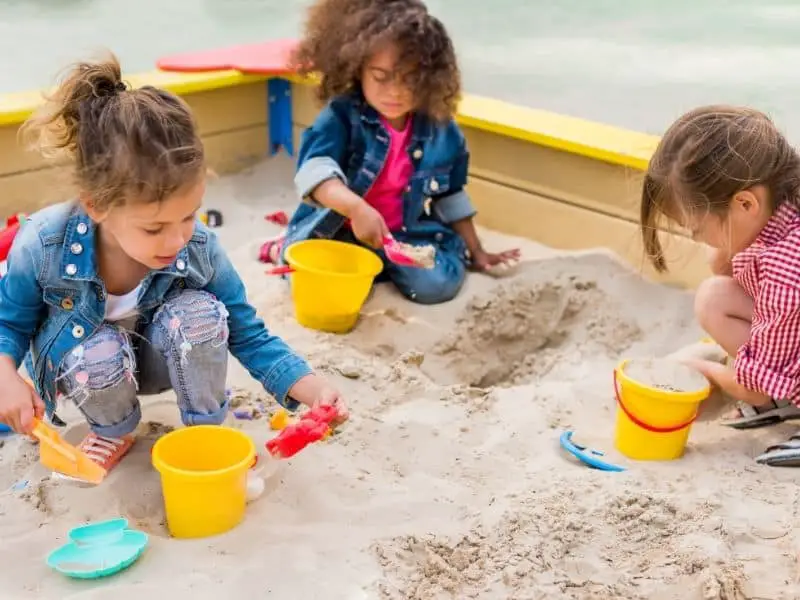Sand is a timeless source of entertainment for children the world over. By itself, sand can spark a child’s imagination and make for hours of interactive playtime. With a little water and a few toys, the possibilities are endless. And this trait doesn’t stop when kids get a little older. I’m not too proud to admit that I still like making sandcastles at the beach. But, getting the best sand for your sandbox is essential. And there are many different types to choose from, like play sand and regular sand.
Play sand and regular sand have some big differences that can impact not only how the sand behaves in the sandbox, but also how safe it is for your kids.
Play sand goes through various processes which make it cleaner, finer, softer, and less dusty than regular (builders) sand, making it suitable for kids sandboxes. In comparison, regular (builders) sand is coarse, dusty, and overall ill-suited for playing with.
Play Sand vs Regular Sand: What’s the Difference?
You may think that sand is sand, right? Get some sand that was previously on a nice beach and call it a day. Unfortunately, it isn’t really that easy. There are some key differences between what’s called play sand and “regular” sand.
Play Sand
Play sand goes through certain processes to remove dust, make the sand uniform, and make sure no foreign objects wind up in it. The best play sand is low-dust or dust free. It’s also fine, which makes it ideal for sand castles. You can get play sand at hardware stores, play stores, and even many garden centers.
Regular Sand
Regular sand is often called builder’s sand or sharp sand. It’s used mostly for construction and usually contains lots of dust, which can be inhaled and cause asthma/allergy issues. It’s also not as fine as play sand, which doesn’t matter much in construction, but makes a big difference if you’re trying to play with it. Since regular sand isn’t fine, it’s often rough to the touch since it contains larger pebbles as well as tiny grains of sand.
Regular sand is usually significantly cheaper than play sand, which makes it an attractive option for under playsets and inside sand boxes. But, before you decide on which sand, read on to learn the real cost of regular sand vs play sand.
Price Difference of Regular and Play Sand
You can expect to pay more for play sand than you would for regular sand, but there’s a good reason for this price difference. The process that play sand goes through usually involves high-pressure water blasting and filtering to make sure that the sand is fine and dust-free.
Regular sand may go through a basic filtering process, but it’s not thorough like the process for play sand.
Still, the range for play sand is pretty wide. There’s play sand available from as low as $6 for 50 pounds and as expensive as $15 for 5 pounds.
Regular bulk sand you can find for as cheap as $25 to $50 per ton.
Potential Health Risks of Sand
When thinking about the cost of sand, it’s important to know about any potential health risks associated with it. There’s two health concerns with sand: crystalline silica and tremolite. I would be remiss if I didn’t address them both. Let’s take them one at a time.
Crystalline Silica
Crystalline silica is another name for quartz. And it’s everywhere. It’s in sand, stone, bricks, mortar, and even certain cosmetics, pet litter, caulk, and talcum powder. But the risk doesn’t come from little granules of crystalline silica. The risk comes from particles small enough to be inhaled.
But, this risk is incredibly small when it comes to children and sandboxes. The people most at risk for health issues related to crystalline silica are construction workers who are involved in sandblasting where the sand is pulverized to make a dust that hangs in the air, which is then breathed in by workers for 15 to 20 years. The same can be said for workers who cut through stone, which also creates breathable dust.
This is the whole reason for the risk of crystalline silica. According to studies and guidance from cancer.gov, it takes many years of breathing this dust in for hours and hours a day for it to cause serious health concerns.
That said, it’s completely understandable if you want to find silica-free play sand. After all, a small risk is still a risk, right? I’ll recommend a silica-free sand for you at the end of this article.
Tremolite
Tremolite is an asbestos-like substance that is found in some crushed limestone and marble. Tremolite poses more of a health risk than crystalline silica, but again, this risk comes from breathing in dust. So finding a good dust-free or low-dust sand is ideal. I’ll also recommend several tremolite-free sands at the end of this article.
How to Tell if Sand is Good for Playing
There are several traits to look for in good, safe play sand. Obviously you can’t tell whether there’s tremolite or crystalline silica in sand just by looking at it, but you can make sure the sand is as safe as possible by doing the following:
- Think about the texture and consistency of white sugar when looking at sand. The best play sand has a similar texture and consistency.
- Dump some sand out of a bag or bucket from about waist-height. Look for dust. If the sand generates a lot of dust, you may not want to use it for your sandbox.
- Use a fine strainer to pick up a random sample of sand and shake it through the strainer. Good play sand shouldn’t leave many large particles behind.
If you do have dusty sand but you know it’s silica- and tremolite-free, you can simply wet the sand a little bit before playtime to reduce the risk of dust getting kicked up and inhaled. Even “safe” sand dust can cause asthma problems in developing lungs. In fact, many play sand manufacturers suggest that you do this, anyway.
Sand and Insects/Animals

No matter what kind of sand you have, it’s bound to attract insects and animals without proper precautions and care. The best way to prevent critters from getting into the sand and/or using it as a bathroom is to cover it when it’s not in use. This could be easier said than done depending on the kind of sandbox you have. Some sandboxes come with a cover, while others may need a tarp or a board for full cover.
Make sure that the sand is dry before covering it up, though. Covered wet sand can breed bacteria and mold. Which brings us to our next section on cleaning the sand.
You Might Also be Interested in Reading: What Kinds of Animals and Insects Do Sandboxes Attract?
Does Sand Need to be Cleaned?
Cleaning your sand regularly is a good idea to help keep your children safe and to prevent any fungus from taking hold in the play area. There are a couple of ways to clean your sand, which we’ll cover below.
How often you clean your sand depends on whether or not you cover the sand when not in use. If you do have a cover that you use regularly, you can probably stick to cleaning the sand two or three times a year. If the sand is exposed to the world when not in use, you’ll want to double that number.
- Rake the sand to unearth and remove any foreign debris.
- Clean Sand with Vinegar
- Mix equal parts vinegar and water in a spray bottle.
- Spray the sand on top, rake it around, and repeat several times.
- Let dry before playtime.
- Clean Sand with Bleach
- Follow the directions above using equal parts bleach and water instead of vinegar and water.
If you have very young kids, you may want to rake the sand before every session to ensure that there’s nothing in there that they will be tempted to put in their mouth, nose, ear, etc.
Does Sand Need to be Replaced?
For best results, replace your sand regularly. Again, how often you do this depends on whether or not you have a cover and how often you clean the sand. Those sandboxes with no cover and minimal cleaning should have the sand replaced once or twice a year.
If you use a cover and clean the sand a couple of times a year, you can go two years before replacing the sand.
Best Sand for Sandboxes and Play Areas
The best sand for sandboxes and play areas is one that is free from tremolite and crystalline silica. Of course, this type of sand is going to be a bit more expensive, but its worth it. With that being said, my personal favorite brand of child-safe play sand is Sandtastik.
It is a bit pricey, coming in at just over a dollar a pound, but, it’s certified by a third-party lab to contain no tremolite and no crystalline silica. This isn’t your normal tan sand, instead it’s white in color and comes in a 25-pound box. It’s ideal for indoor and outdoor use. It also contains minimal dust and is great for making sandcastles when you add a little water.
You can get large bags of play sand at your local hardware store for much cheaper than this. But, since there’s no mandated testing in place for tremolite, the sand you get there COULD contain tremolite. It almost certainly contains crystalline silica, just like sand at most beaches around the world.
This is why I recommend the Sandtastik above. It’s one of the few brands that doesn’t have either. So if you don’t want to risk exposure to these particles, you can rest easy with Sandtastik white play sand.
- Use in sand boxes or tables
- Ideal for early childhood classrooms or childcare...
- Create castles or sculptures by adding a little water
- Note: shovel and bucket are not included
If you’re buying for a large play area instead of a smaller sandbox, you may want to avoid sand altogether and go for something like mulch, wood chips, or engineered wood fiber.
In Conclusion
Sand for sandboxes is one of those things that many parents are on either side of. Some parents are worried about the potential health risks while others don’t see much of a problem. Either way, I hope this article helps you choose the right sand for you.
Kids love sand and playing in it helps them develop fine motor skills and can provide hours of entertainment. But if kids are going to be playing in it, you generally want to use play sand and not regular sand. What type of play sand you choose is a different story, which I’ll leave up to you!
Thanks for reading!


